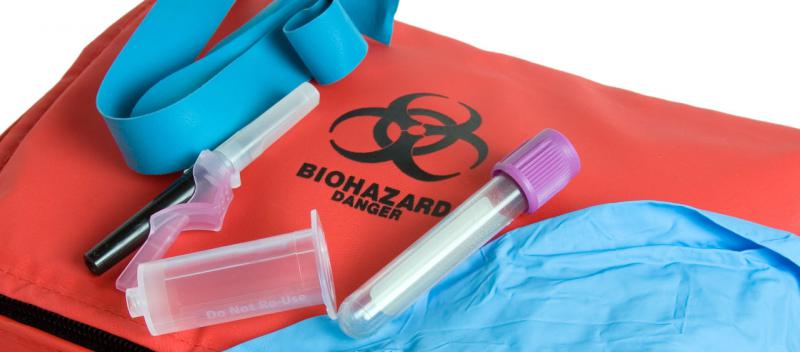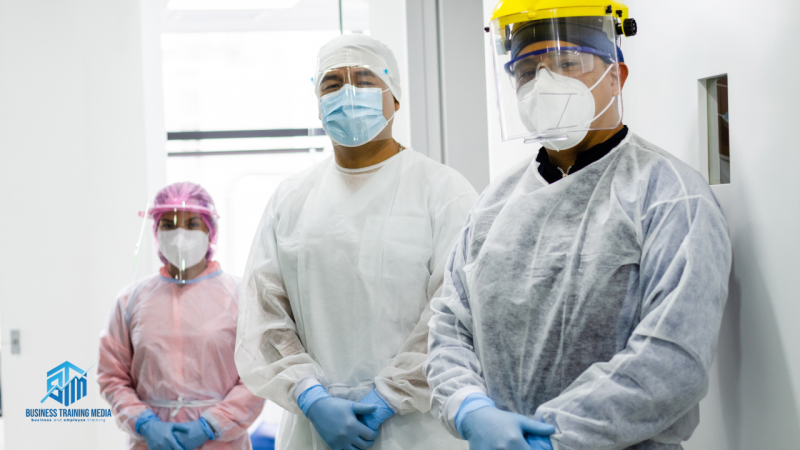
Healthcare Facility Bloodborne Pathogens Safety Videos
By Business Training Media
Bloodborne pathogens are microorganisms that can cause diseases when transmitted through blood or other potentially infectious materials. In healthcare facilities, the risk of exposure to bloodborne diseases, such as HIV, Hepatitis B, and Hepatitis C, is a significant concern for both healthcare workers and patients. As infection rates for hepatitis B and hepatitis C rise, it becomes crucial for healthcare employees to be well-informed about the hazards associated with bloodborne pathogens and the preventive measures in place.
This article will discuss key aspects of bloodborne pathogen management in healthcare settings, including HIV, hepatitis, sources of infection, exposure control plans, biohazard labeling, risk reduction strategies, personal protective equipment (PPE), hepatitis vaccination, and post-exposure procedures.
Understanding HIV, Hepatitis, and Sources of Infection:
HIV (Human Immunodeficiency Virus) and Hepatitis B and C are among the primary bloodborne pathogens of concern in healthcare settings. HIV can lead to AIDS (Acquired Immunodeficiency Syndrome), while Hepatitis B and C can cause chronic liver infections and lead to severe complications, including liver cirrhosis and liver cancer. Healthcare workers can be exposed to these pathogens through contact with blood, body fluids, and contaminated surfaces, highlighting the need for comprehensive training on modes of transmission and preventive measures.
The Exposure Control Plan:
One of the cornerstones of bloodborne pathogen management is the development and implementation of an exposure control plan (ECP). This plan outlines procedures and practices to minimize the risk of exposure to bloodborne pathogens. It includes elements such as safe work practices, engineering controls, and the use of personal protective equipment (PPE). Regular training and updates on the ECP are essential for healthcare workers to stay informed about the latest guidelines and protocols.
Biohazard Labeling:
Proper biohazard labeling is crucial in healthcare facilities to identify materials or equipment that may be contaminated with bloodborne pathogens. Clear and standardized labels help prevent accidental exposures and ensure the safe handling and disposal of potentially infectious materials. Adherence to biohazard labeling guidelines is a key component of the overall safety strategy in healthcare environments.
Reducing the Risk of Exposure:
Minimizing the risk of exposure to bloodborne pathogens involves a combination of engineering controls, administrative controls, and work practices. This includes the proper handling and disposal of sharps, the use of safer medical devices, and the implementation of infection control measures. Regular training programs should emphasize the importance of vigilance and adherence to established safety protocols in daily healthcare practices.
Personal Protective Equipment (PPE):
The use of appropriate personal protective equipment is fundamental in preventing the transmission of bloodborne diseases. Healthcare workers should be trained on the selection, use, and disposal of PPE, which may include gloves, masks, gowns, and eye protection. Ensuring the availability and proper use of PPE is essential for maintaining a safe working environment.
Hepatitis Vaccination:
Vaccination is a key preventive measure against hepatitis B. Healthcare employers should offer the Hepatitis B vaccination to all employees at risk of occupational exposure. Encouraging vaccination helps protect healthcare workers from potential infections and contributes to overall workplace safety.
Post-Exposure Procedures:
In the event of an exposure incident, prompt and appropriate action is crucial. Healthcare workers should be familiar with the post-exposure procedures outlined in the ECP, including reporting the incident, seeking medical attention, and documenting the exposure. Timely response and follow-up can mitigate the potential consequences of exposure to bloodborne pathogens.
As the prevalence of bloodborne diseases continues to be a significant concern in healthcare, understanding and managing bloodborne pathogens are critical components of ensuring a safe working environment. Comprehensive training programs, strict adherence to exposure control plans, proper use of personal protective equipment, and vaccination initiatives contribute to the overall goal of minimizing the risk of transmission and protecting the health and well-being of healthcare workers. By prioritizing education and safety measures, healthcare facilities can create an environment where the risk of exposure to bloodborne pathogens is significantly reduced.
Business Training Media, Copyright 2023
Join Our Free HR & Workplace Training Solutions eNewletter
Join our free HR and Workforce Training Solutions eNewsletter today to stay up-to-date on the latest industry trends, training and development programs, best practices, and expert insights. Gain valuable knowledge, enhance your skills, improve your organization, build productive teams, and elevate your career. Don't miss out on this invaluable resource. Sign up now for our free eNewsletter!

Bloodborne Pathogens in Healthcare Facilities Safety Video

Bloodborne Pathogens: Universal Precautions

Bloodborne Pathogens Part 1: What is a Bloodborne Pathogen?





